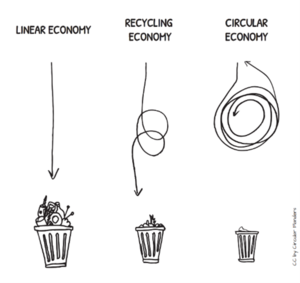Circular Economy
There is only one planet Earth, yet by 2050, the world will be consuming as if there were three. The EU’s transition to a circular economy will reduce pressure on natural resources, create sustainable growth and jobs, and is necessary to achieve the EU’s 2050 climate neutrality target and to halt biodiversity loss.
In our current economy, we take materials from the Earth, make products from them, and eventually throw them away as waste – the process is linear. In a circular economy, by contrast, we stop waste being produced in the first place.
Three principles

The circular economy is based on three principles, driven by design:
- Eliminate waste and pollution
- Circulate products and materials (at their highest value)
- Regenerate nature
It is underpinned by a transition to renewable energy and materials. A circular economy decouples economic activity from the consumption of finite resources. It is a resilient system that is good for business, people and the environment.
The World Economic Forum’s Definition Of Circular Economy
“A circular economy is an industrial system that is restorative or regenerative by intention and design. It replaces the end-of-life concept with restoration, shifts towards the use of renewable energy, eliminates the use of toxic chemicals, which impair reuse and return to the biosphere, and aims for the elimination of waste through the superior design of materials, products, systems, and business models. ”
Please take a look at this video where Ellen MacArthur talks about the basics of circular economy